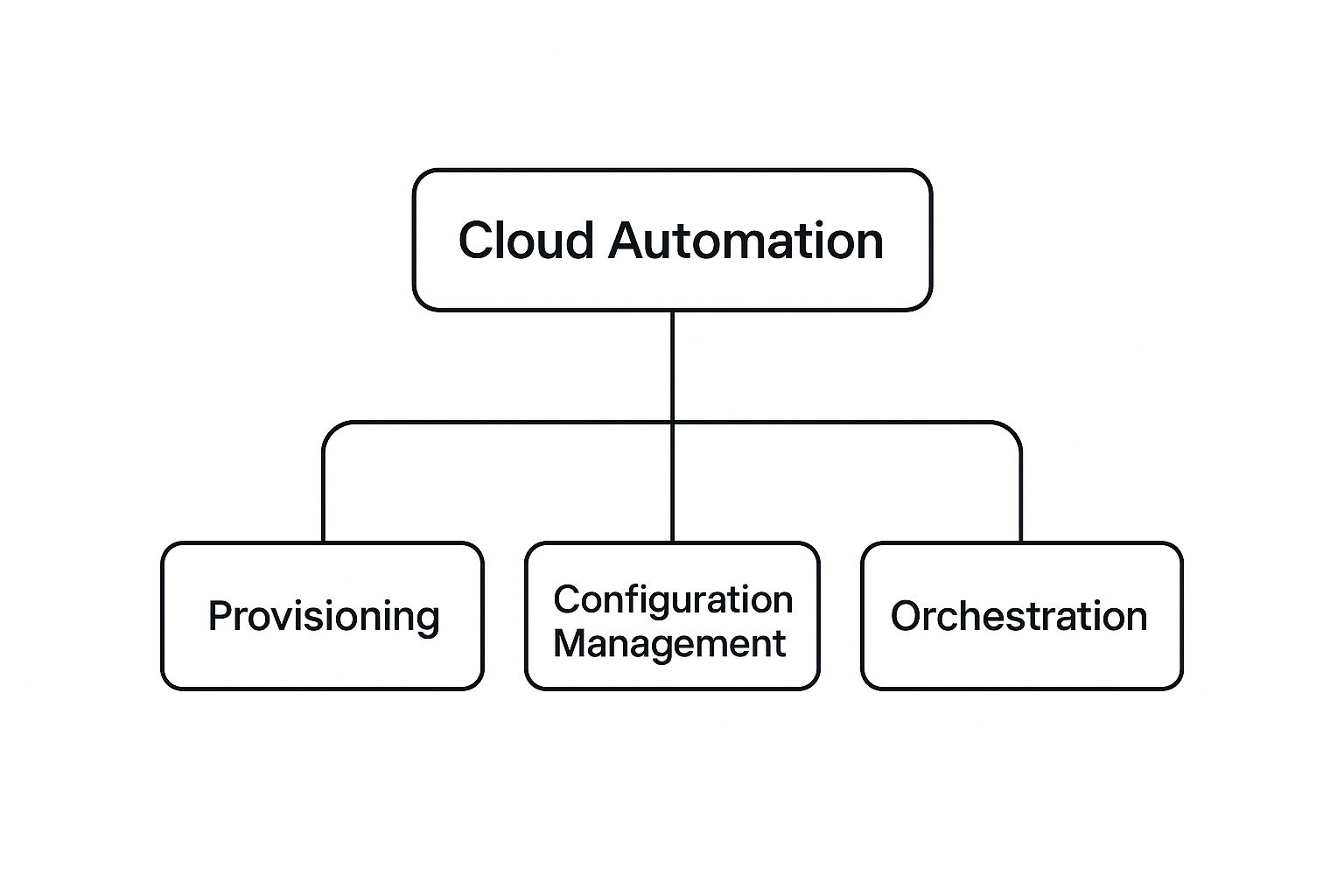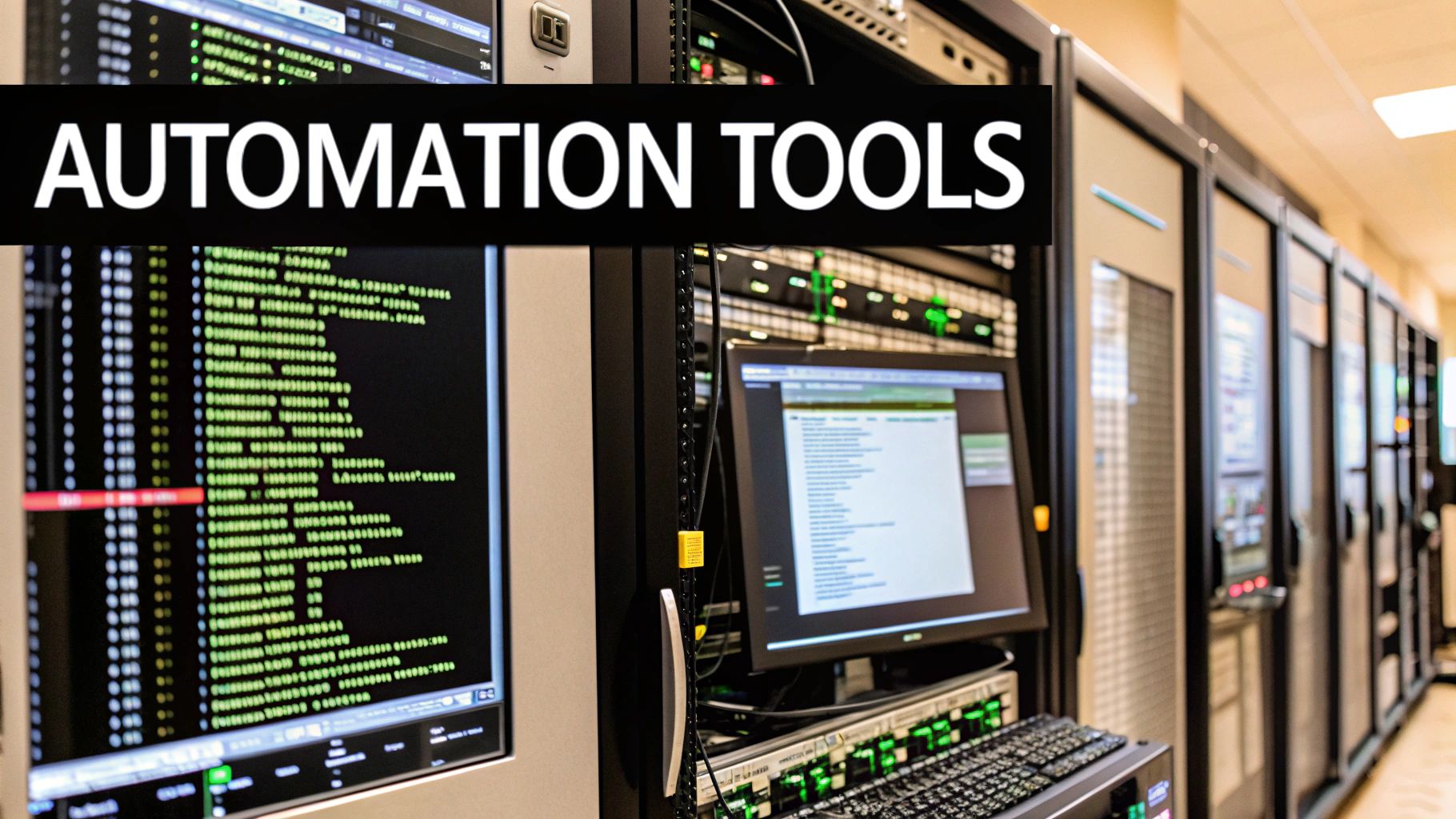What Is Cloud Automation Explained Simply
Let's be real for a moment. Managing a cloud environment without automation is like trying to run a modern factory entirely by hand. You might get it done, but it's slow, expensive, and you're bound to make mistakes.
So, what is cloud automation?
Simply put, cloud automation is about using specialized software to take over the repetitive, manual chores involved in managing cloud-based systems. Instead of a person clicking through menus to set up a server or deploy an update, you write a script or a set of rules that tells the software how to do it. The tools then handle the rest, flawlessly, every single time.
This is the secret to managing today's complex cloud infrastructure with both speed and consistency.
What Is Cloud Automation in Simple Terms

Think about it like this: imagine you're the pilot of a massive commercial airliner. You set the flight path and make the big decisions, but you're not manually adjusting the flaps and rudder for the entire six-hour flight. The autopilot handles the thousands of tiny, constant adjustments needed to keep the plane stable and on course.
Cloud automation is the autopilot for your IT infrastructure. Your engineers set the "flight plan"—the rules, configurations, and desired outcomes—and the automation tools execute those instructions with machine precision. This frees up your team to focus on innovation and strategy, not tedious, error-prone tasks.
The Foundation of Modern Cloud Operations
At its core, cloud automation is about building a more intelligent and responsive infrastructure. You move from a reactive state, where you're constantly putting out fires, to a proactive one, where the system largely manages itself. For any business that wants to grow, innovate quickly, and stay reliable, this isn't just a nice-to-have; it's a necessity.
Here's a quick look at what that looks like in practice:
To quickly summarize the key functions, this table breaks down the core components of a cloud automation strategy and what they aim to achieve.
Cloud Automation at a Glance
| Component | Primary Goal |
|---|---|
| Provisioning | Automatically create and configure servers, databases, and networks. |
| Configuration Management | Ensure all systems maintain a consistent, desired state. |
| Monitoring & Remediation | Detect issues and automatically trigger corrective actions. |
| CI/CD Pipelines | Automate the building, testing, and deployment of applications. |
| Security & Compliance | Enforce security policies and audit compliance automatically. |
This approach shifts the focus from manual execution to strategic definition, making your entire cloud operation more efficient and predictable.
The real game-changer is turning your infrastructure into code. When you define processes as code, your entire system becomes predictable, repeatable, and transparent.
Every action is logged, version-controlled, and auditable. You're not just building servers; you're building a reliable, self-sustaining system.
This concept of codifying processes is a core principle in many areas of technology. The principles are quite similar when you dig into what is workflow automation, where the goal is always to create efficient, repeatable systems. At the end of the day, automation is the engine that powers modern, agile cloud operations.
Understanding the Engine Behind Cloud Automation
Cloud automation isn’t just a single piece of software or a button you push. It’s more like a highly coordinated, autonomous crew building and managing your digital infrastructure. Think of it this way: each component has a specific job, but they all work together seamlessly to get things done with incredible speed and accuracy.
To really get what cloud automation is all about, you need to understand the pieces that make it work. It helps to see how automation acts as a core operational engine in other business areas, like B2B operations, to appreciate its role here.
This infographic gives a great high-level view of how these core parts fit together.

As you can see, orchestration is the conductor, making sure provisioning and configuration management all happen in concert.
The Key Components
Let's pull back the curtain on the most critical parts of this automation engine. These are the gears that turn simple lines of code into a fully functional, self-managing cloud system.
-
Infrastructure as Code (IaC): This is the master blueprint for your entire cloud setup. Instead of clicking around a console to set up servers and networks, you write code that defines every single resource. This means every deployment is identical, predictable, and self-documenting. No more manual errors or "it worked on my machine" issues.
-
Automated Provisioning: If IaC is the blueprint, think of provisioning as the robotic construction crew that reads it. This component automatically creates and assigns all the resources you need—virtual machines, databases, storage—based exactly on what's defined in your IaC scripts.
-
Orchestration: This is the project manager keeping the whole operation on track. Orchestration is the brains of the outfit, coordinating all the different automated tasks to make sure they run in the right order. It kicks off provisioning, handles configurations, and ties various tools together into one smooth workflow. Getting orchestration right is key for managing complex systems, a concept we dive into in our guide to data integration best practices.
It's no surprise that the adoption of these tools is exploding. The global cloud automation market was valued at USD 159.07 billion and is expected to rocket to USD 479.76 billion by 2032.
That’s a massive 20.2% annual growth rate, which shows just how seriously companies are taking cloud automation.
The Real-World Benefits of Automating Your Cloud

It's one thing to understand the mechanics of cloud automation, but the real story is how it affects your bottom line. Bringing automation into your cloud environment isn't just a tech upgrade—it's a smart business move with tangible, measurable payoffs.
The first thing you'll notice is a huge jump in operational efficiency. Think about all the routine, manual work your team does: provisioning servers, patching software, running backups. Automation handles all of that, freeing up your talented engineers to tackle complex problems and innovate instead of getting bogged down in repetitive tasks.
Speed Up Growth and Lock Down Security
Beyond just making things run smoother, automation gives you a serious competitive advantage. It dramatically shrinks your time-to-market by making application deployments fast and repeatable. Imagine pushing new features from an engineer's keyboard to live production in minutes, not weeks. That’s the kind of speed that wins.
At the same time, your security gets a massive upgrade. Automation enforces your exact security policies and configurations across every single part of your infrastructure, every time. It takes human error—a primary cause of security breaches—out of the equation.
By turning your security and compliance policies into code, you build an environment that’s secure by design. Every new resource that spins up is automatically locked down to your standards, closing security holes before they even open.
Get a Handle on Costs and Resources
Finally, let's talk about one of the most persuasive benefits: significant cost savings. Cloud automation tools are masters of resource optimization. For instance, auto-scaling can instantly add servers to manage a sudden traffic surge and—just as critically—shut them down when things get quiet.
This means you stop paying for idle capacity and only use what you need, when you need it. This kind of intelligent management stretches every dollar of your cloud budget, making the business case for automation crystal clear.
How Different Industries Use Cloud Automation
Cloud automation isn't some abstract concept locked away in the IT department. It’s a real-world tool that gives companies a serious competitive edge, no matter their industry. The beauty of it is its flexibility; it can be molded to solve the unique challenges you’ll find everywhere from retail to healthcare.
Think about a major e-commerce store on Black Friday. The traffic surge is massive and chaotic. Instead of having a team manually scramble to add more servers, automation handles it instantly. As millions of shoppers hit the site, automated systems spin up hundreds of extra servers on the fly, keeping the site from crashing and ensuring customers can actually buy things. Once the frenzy is over, everything scales back down automatically, saving a fortune in server costs.
Securing Finance and Accelerating Healthcare
The game changes completely in a sector like fintech, where security and compliance aren't just best practices—they're the law. Here, cloud automation is absolutely critical for enforcing complex financial regulations.
For a fintech company, automation means deploying systems where every single compliance check and security protocol is baked in from the start, all managed by code. This takes human error out of the equation for critical tasks, letting them meet tough standards without killing the momentum of innovation.
You see the same idea at play in healthcare. When a hospital needs to get a new patient data system up and running, automation ensures the environment is provisioned quickly and securely, meeting all privacy rules like HIPAA right out of the box.
- Retail: Manages huge, unpredictable traffic spikes with auto-scaling.
- Fintech: Enforces intricate compliance and security policies without manual oversight.
- Healthcare: Deploys secure, compliant patient systems quickly and consistently.
These are just a handful of the many powerful business automation examples that show how companies are shaping these tools to fit what they do. This adaptability is what’s fueling its massive growth, with the market projected to expand at a compound annual growth rate of 21.0% from 2025 to 2030. You can discover more insights about this expanding market on Mordor Intelligence.
Your First Steps in Cloud Automation

Jumping into cloud automation can feel overwhelming, but the secret is to start small. Don't try to automate your entire infrastructure overnight—that’s a recipe for disaster. Instead, think like a surgeon, not a bulldozer.
Look for a pilot project. Pinpoint one repetitive, time-consuming task that your team dreads. Is it spinning up new dev environments? Maybe it's the nightly data backup process that someone has to babysit. By focusing on a single, high-impact area, you can score a quick win. This builds confidence and shows everyone else the real-world value of automation right away.
Choosing Your Tools and Fostering the Right Culture
With a target in your sights, it's time to pick your tools. The right choice depends entirely on what you’re trying to automate.
- Configuration Management: If you need to keep servers and applications configured consistently, look at tools like Ansible or Puppet. They ensure every environment matches your defined blueprint.
- Orchestration Engines: To manage your entire infrastructure as code, platforms like Terraform or AWS CloudFormation are indispensable. They make complex deployments repeatable and predictable.
- CI/CD Tools: For automating the software delivery pipeline, tools like Jenkins or GitLab CI/CD handle everything from code check-in to deployment.
But great tools alone won't get you there. You also need a cultural shift—a DevOps mindset. This is all about breaking down the walls between developers and operations teams. You have to reframe automation as an ally that frees people from tedious work, not as a threat to their jobs.
The goal is to build a culture where automation is the default, not the exception. When teams embrace this, they start building more resilient, efficient, and innovative systems from the very beginning.
Finally, you need to prove it works. Set clear, measurable goals for your pilot. Do you want to reduce deployment time by 50%? Are you aiming to slash manual errors by 90%? Tracking these numbers is how you demonstrate a real return on investment (ROI) and build the case for expanding your automation efforts.
The value is undeniable, and the market knows it. The global cloud computing market was valued at USD 752.44 billion and is expected to hit USD 2,390.18 billion by 2030. You can learn more about these market projections to see just how big this opportunity is.
Frequently Asked Questions About Cloud Automation
Getting started with cloud automation is exciting, but a few questions always pop up as people dig deeper. Let's tackle the most common ones to give you a clearer, more practical understanding of how this all works in the real world.
Think of this as the "now, how does this actually apply to me?" part of the guide.
Is Cloud Automation the Same as Orchestration?
It's a common point of confusion, but no, they're different sides of the same coin. They work together, but they aren’t the same thing.
Imagine you're building a house.
Cloud automation is a single, specific action, like a nail gun that automatically drives a nail perfectly every time. It’s one task, done quickly and reliably.
Orchestration is the general contractor managing the entire construction project. It ensures the foundation is poured before the framing goes up, and the wiring is done before the drywall is installed. Orchestration is what coordinates all those individual automated tasks into a single, seamless workflow.
In short, orchestration is the brain that tells all the individual automated "muscles" what to do and when to do it. You need both to build anything complex.
Can Small Businesses Benefit from Cloud Automation?
Absolutely. In fact, you could argue that small businesses stand to gain even more than massive corporations.
For a small or medium-sized business, every person’s time is incredibly valuable. Automating tedious but essential tasks—think data backups, server updates, or new user setups—frees your team from the grind. They can stop putting out fires and start focusing on innovation, customer relationships, and growing the company.
Automation helps smaller teams punch above their weight, giving them the efficiency and resilience of a much larger organization without the massive payroll.
Does Cloud Automation Eliminate the Need for IT Staff?
Not at all. This is one of the biggest myths out there. It doesn’t replace IT staff; it elevates their role.
Instead of getting bogged down with repetitive, manual tasks, IT pros get to shift their energy to more strategic, high-impact work. Their job evolves from maintenance to creation.
Their focus changes to things like:
- Designing and refining the automation workflows that power the business.
- Optimizing cloud spending and ensuring peak performance.
- Driving innovation and implementing more sophisticated security measures.
Automation turns your IT team from system mechanics into system architects. It empowers them to deliver far more value than they ever could when buried in manual work.
Ready to stop wasting time on manual processes and start scaling your operations? The team at MakeAutomation specializes in building the exact automation frameworks that B2B and SaaS companies need to accelerate growth. Explore our services and book a consultation today.







